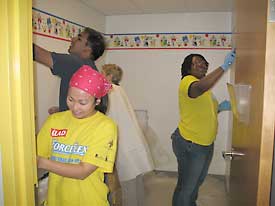
This web page is part of the Michigan Today Archive. To see this story in its original context, click here.
U-M students, staff spring to action near Gulf CoastBy Kevin BrownIt's hard to imagine that a "pristine sea could rise up, become a monster and swallow people's homes and destroy their lives," wrote U-M graduate student Megan Hoelle as she joined other students and faculty during spring break to help New Orleans-Gulf Coast hurricane victims.
"The destruction goes on for miles and miles, with downed trees dressed in people's sheets and clothes, bare foundations and the occasional FEMA trailer the only real landmark," wrote Hoelle, a graduate student instructor, in a blog on the School of Public Health (SPH) Public Health Action Support Team (PHAST) Web site. JoLynn Montgomery, a member of the research faculty in the Department of Epidemiology, was struck by the many "blue roofs" she spotted as the airplane carrying 45 PHAST volunteers descended upon New Orleans. The blue tarpaulins are needed to protect homes after the storm swept away roofs. Montgomery and other U-M volunteers who chose to spend spring break helping in the storm-ravaged Gulf Coast region say they also were struck by the wide-ranging devastation and the realization that recovery work must continue. "I think the biggest thing is this is going to take a very long time to rebuild. They really need a new infusion of new ideas and energy," Montgomery says, as the recovery understandably has worn survivors down. Esperanza Barcelona, a residence life manager with the Ann Arbor Ecumenical Center and International Residence, which works with the U-M International Center, traveled to Biloxi, Miss., as part of a volunteer group of four adults and 22 U-M students. "We saw a lot of blue (tarpaulin-covered) roofs waiting to be rebuilt; piles of wood, piles of steel, things that had been removed for either recycling or to make mulch out of them, the piles of garbage that had already been picked up," she says. The volunteers were instructed to bring gloves and face masks to protect themselves from mold as they handled materials while aiding the ongoing cleanup. The group's appearance was organized by a Biloxi church group, which outfitted volunteers in yellow T-shirts. "We were so warmly welcomed," Barcelona says. "People saw our yellow shirts and they'd start honking horns." The group spent nights sleeping in a church gymnasium. The SPH volunteer effort also designed to enhance classroom learning was organized by the Office of Public Health Practice in the dean's office. It was coordinated with PHAST, recently established to respond to public health concerns and emergencies. The Gulf Coast trip was its first sizeable project. "After the hurricane (Katrina) everyone wanted to do something. This was organized through the dean's office, to give students an opportunity to participate in a public health volunteer effort," Montgomery says. In the weeks leading up to the break, posters around the SPH announced that volunteers were being sought, and e-mails also publicized the volunteer effort to students. Those who signed up underwent several hours of training over three days.
Montgomery says work included studying contamination at Murphy Oil Refinery in St. Bernard's Parish, where storms caused an oil spill. Students evaluated the potential public health risks, and worked with the damaged St. Thomas Clinic in New Orleans. "A lot of water got in, there was termite damage, the students did a lot of painting and patching, they helped reorganize the pharmacy," she says. Because much more recovery work is needed, Montgomery says the SPH plans to continue pursuing ways to help. "There are so many issues; it's overwhelming. People are just starting to move back really," she says. Barcelona says student volunteers organized through the Ecumenical Center also plan to continue to aid the recovery. One of those students, LSA freshman Elizabeth Brouwer recalls nailing boards and shingles for much of the week she volunteered. "However, on the last Saturday of the week, a group of us went around doing odd jobs for several people. These were maybe the most memorable (experiences) for me just in the way the families reacted," Brouwer says. One woman had boxes of photos and books stored high in her garage to save from the storm, and she wanted them returned to her house. "Then her couch needed to be moved back into her living room," Brouwer says. "When she saw her furniture back in place, she started crying, saying that her house finally looked normal again for the first time after the storm. "No matter how much money you had or how bad the damage to your property, everyone suffered," she says. "These last experiences helped show me that and made me glad I could do even a little bit of work to chip in." |
|
Michigan Today News-e is a monthly electronic publication for alumni and friends. |
| MToday NewsE | |
|
|
Michigan Today
online alumni magazine
University Record
faculty & staff newspaper
MGoBlue
athletics
News Service
U-M news
Photo Services
U-M photography
University of Michigan
gateway


